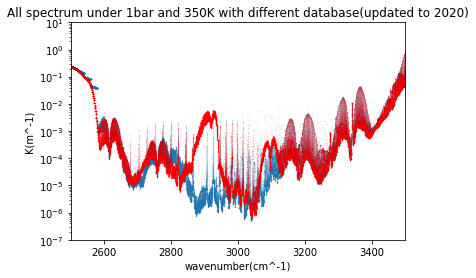Update of the thermal radiative transfer in the Venus PCM
- 1Sorbonne University, Laboratoire de Météorologie Dynamique (LMD/IPSL), France (peng.han@lmd.ipsl.fr)
- 2Laboratoire d'astrophysique de Bordeaux, Univ. Bordeaux, CNRS, B18N, allée Geoffroy Saint-Hilaire, 33615 Pessac, France
- Introduction
The Venus PCM (Planetary Climate Model) [1,2] has been using a pre-computed net exchange rate (NER) matrix formalism to calculate the infrared radiative transfer in the wavelength range, from 1.7 to 250 μm. This implementation allows the Venus PCM to compute temperature self-consistently. However, this formalism has a drawback, as the cloud model has to be fixed in the computation of the NER matrix, decoupled from the Venus PCM. In this work, we present recent improvements done to the infrared radiative transfer, in order to improve the Venus PCM performances.
- Update of the opacity properties
When calculating the NER coefficients, the high-resolution spectrum data, cloud opacities, and Collision induced absorption (CIA) are integrated [3]. As the dominant gas compound, CO2 dominates most of the energy exchange. In this work, the high-resolution spectrum data of different molecules are updated to the latest version as Figure 1 shows. A new combination of sub-lorentzian far-wing profiles of CO2 is also considered [4,5,6]. The influence of this update on the energy exchange, as discussed in [7], will be presented.

Figure 1: The comparison of the total spectrum absorption coefficient calculated under 1bar 350K for the 2500-3500 cm-1 wavenumber range. The blue line presents the former database used in the Venus PCM, and the red line is for the results using the updated HITRAN database
- A new IR scheme
A new scheme is now implemented to compute online the radiative transfer both for the solar and for the infrared radiation. This scheme, based on the radiative transfer scheme used in the Generic PCM, allows us to include a better coupling between opacity distributions and dynamics in the model [8]. In particular, it will allow a full coupling between cloud distributions (soon to be consistently modeled thanks to a full microphysical module), temperature structure and atmospheric dynamics. This provides more flexibility to study radiative sensitivity to opacity sources.
The different temperature structures simulated in the deep atmosphere using each of the two schemes are compared, as well as the energy exchange rates in the important windows such as 3-7 μm [7]. This update will help us to better understand the mechanisms that control temperature and dynamical structure in the deep atmosphere.
References
[1] Lebonnois, S., Sugimoto, N., & Gilli, G. (2016). Icarus, 278, 38-51, doi : 10.1016/j.icarus.2016.06.004
[2] Garate-Lopez, I., & Lebonnois, S. (2018). Icarus, 314, 1-11, doi : 10.1016/j.icarus.2018.05.011
[3] Eymet, V., Fournier, R., Dufresne, J. L., Lebonnois, S., Hourdin, F., & Bullock, M. A. (2009). Journal of Geophysical Research: Planets, 114(E11), doi : 10.1029/2008JE003276
[4] Tran, H., Boulet, C., Stefani, S., Snels, M., & Piccioni, G. (2011). Journal of Quantitative Spectroscopy and Radiative Transfer, 112(6), 925-936, doi : 10.1016/j.jqsrt.2010.11.021
[5] Tonkov, M. V., Filippov, N. N., Bertsev, V. V., Bouanich, J. P., Van-Thanh, N., Brodbeck, C., ... & Le Doucen, R. (1996). Applied optics, 35(24), 4863-4870.
[6] Pollack, J. B., Dalton, J. B., Grinspoon, D., Wattson, R. B., Freedman, R., Crisp, D., ... & Tipping, R. (1993). Icarus, 103(1), 1-42, doi : 10.1006/icar.1993.1055
[7] Lebonnois, S., Eymet, V., Lee, C., & Vatant d'Ollone, J. (2015). Journal of Geophysical Research: Planets, 120(6), 1186-1200, doi : 10.1002/2015JE004794
[8] Turbet, M., Leconte, J., Selsis, F., Bolmont, E., Forget, F., Ribas,I., Raymond, S., Anglada-Escudé, G. (2016). Astronomy & Astrophysics, 596, A112, doi:10.1051/0004-6361/201629577
How to cite: Han, P., Lebonnois, S., and Turbet, M.: Update of the thermal radiative transfer in the Venus PCM, Europlanet Science Congress 2024, Berlin, Germany, 8–13 Sep 2024, EPSC2024-344, https://doi.org/10.5194/epsc2024-344, 2024.